June 19th, 2012
| 5 Comments »
I’ve been on a mostly plant-based eating plan for just over a year now and have no intention of ever going back to eating meat on a regular basis. I’m not against having a bit of it here and there if the mood suits me, but with a heightened awareness of how it deeply affected my health, I’m off of the stuff for the long term.
Trouble is, I’ve been searching for cooking inspiration and while I can find a great deal online in the blogs that I follow, I hadn’t come across a really good source until I serendipitously found Michael Natkin’s blog, Herbivoracious, and within a day’s time was invited to a local book signing with the author. Everyone who attended the event received a complimentary cookbook and several tantalizing bites from the simple and gorgeous recipes in the book.
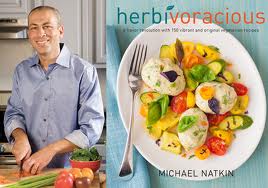
I haven’t devoured a cookbook like this in a very long time. I’ve purchased a few promising vegetarian cookbooks through used book stores, but have come away from them feeling uninspired, or worse, dismayed at the boring recipes. In our current state of food, with a wealth of ingredients available to us, fresh produce everywhere and home cooks hitting up the internet with abandon to share their stories and recipes, we shouldn’t feel like pasta and vegetables make up the bulk of a vegetarians meals, but that was the message a lot of vegetarian cookbooks still seem to send. I wanted something that reflected the modern cuisine, full of a wide selection of fresh ingredients, unique spices, terrific grains and a grown-up mentality towards consumption of plant-based foods. Just a few pages in to Michael’s book and I knew I’d found what I was looking for, breathing an excited sigh of relief. I immediately started marking pages, rich with inspiration, my mouth already watering over what was to come.
One aspect of this book that I love is that it mirrors my own cooking philosophy, in that a recipe should be a guide, and not a cut and dried interpretation of the finished dish. Michael clearly discusses ways to change up his recipes, suggesting additional ingredients or substitutions and encouraging the reader to utilize what’s on hand. Every dish is simple, yet elegant, running the whole range of time needed for completing the recipes from about 10 minutes to pull together an easy salad to longer, in-depth recipes for those special occasions. The book is full of advice on sourcing ingredients, caring for your knives, planning your meals and making your prep easier to manage; he covers so many little details that it makes the book more than just a cookbook, but something akin to treasured kitchen advice. The cover page is gorgeous, but if it gets torn, stained or otherwise in your exploration, the actual cover itself still has it’s beautiful logo. I like that in a book.
Even while still at the book signing event, chatting excitedly with a few friends and paging through the book, I came across the Golden Beet Tartare recipe and knew that would be tops on my list. I adore gold beets and it sounded like a delicious summery salad for a hot, sticky day.
I wasn’t wrong at all about that. The heat is on, Minnesota. It’s time to stay cool, right?

Fresh and bright, this simple salad has crunch and texture galore, the rich earthy taste of beets and mellow cucumber and onion. The original recipe called for raw red onion which I don’t ever use as I dislike raw allium in anything, so I substituted grilled vidalia onions with just enough snap remaining. Once it was all pulled together I thought it still needed a bit more color to jazz up the visual aspect, so I finely chopped some kale leaves that gave it the perfect balance.
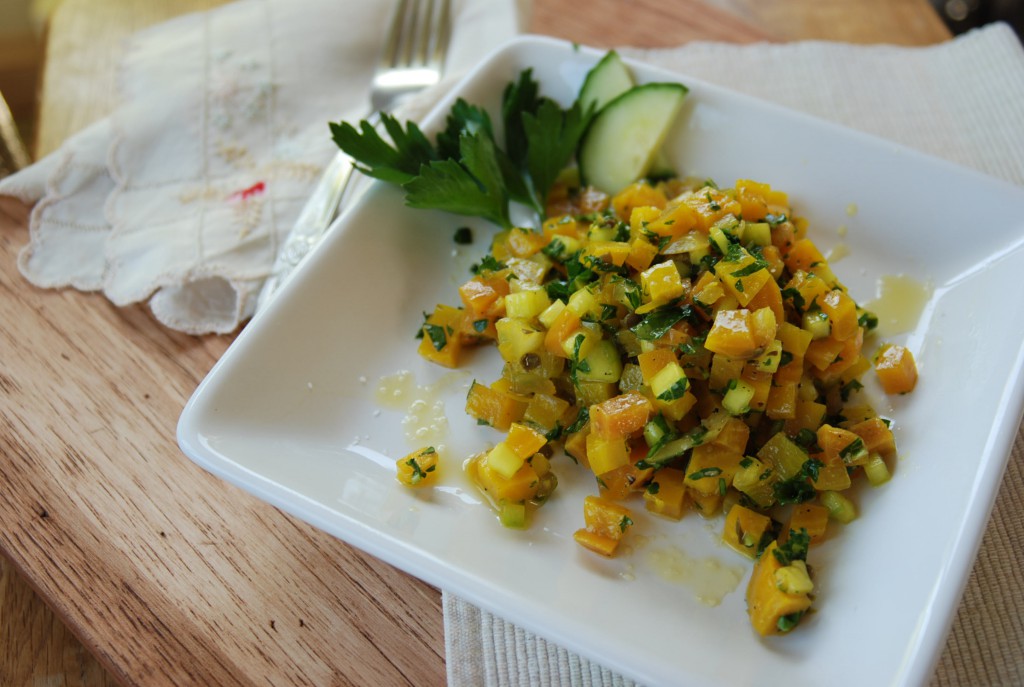
I can foresee this recipe becoming a regular in my kitchen, giving it repeated appearances and endangering my endless love of beets. With the upcoming beet season looming, and such pretty colors and patterns in this nutritious and healthy root vegetable, I vow to practice enough restraint to keep it fresh and desirable so we can continue to enjoy it’s benefits. Right now, I’m fighting off the urge to consume the entire container of this salad. A definite winner.
Please visit Michael’s site, for his complete recipe for Golden Beet Tartare. I’m going to give you my method, which, as Michael encourages, is my own take on the recipe.
Golden Beet Salad
3 medium beets, tops trimmed (save them and eat them if it’s your thing)
1/2 an English Cucumber, peeled and finely diced
1/2 medium Vidalia onion, grilled but still somewhat crunchy, finely diced
1 T. capers, drained and minced
1/2 c. kale leaves, finely minced
3 T. olive oil
1 t. fresh lemon zest
1 T. fresh squeezed lemon juice
1 T. fresh chives, minced
2 T. fresh parsley, minced (I used flat leaf; curly would work just as well)
Sea salt and fresh ground black pepper
Heat oven to 400°. Place a square of foil in an 8×8 baking pan and put beets in the foil. Drizzle with a bit of olive oil and fold the foil over the beets. Roast the beets until a knife inserted in them slips out easily. The time will depend on the size of your beets, but plan for at least 45 minutes to an hour. Allow the beets to cool, then peel and dice them.
In a bowl, add the beets, cucumber, onion, capers, kale, lemon zest and juice, chives and parsley. Drizzle in the oil, add a few shakes of sea salt and grinds of pepper. Stir to combine and taste for seasoning. Allowing the salad to sit for a few hours, or overnight before serving will deepen the flavors. Adjust seasonings before serving.
DISCLAIMER:
I received a complimentary copy of Herbivoracious from attending the book signing event.
All opinions and feedback about the book are strictly my own.
May 5th, 2012
| 2 Comments »
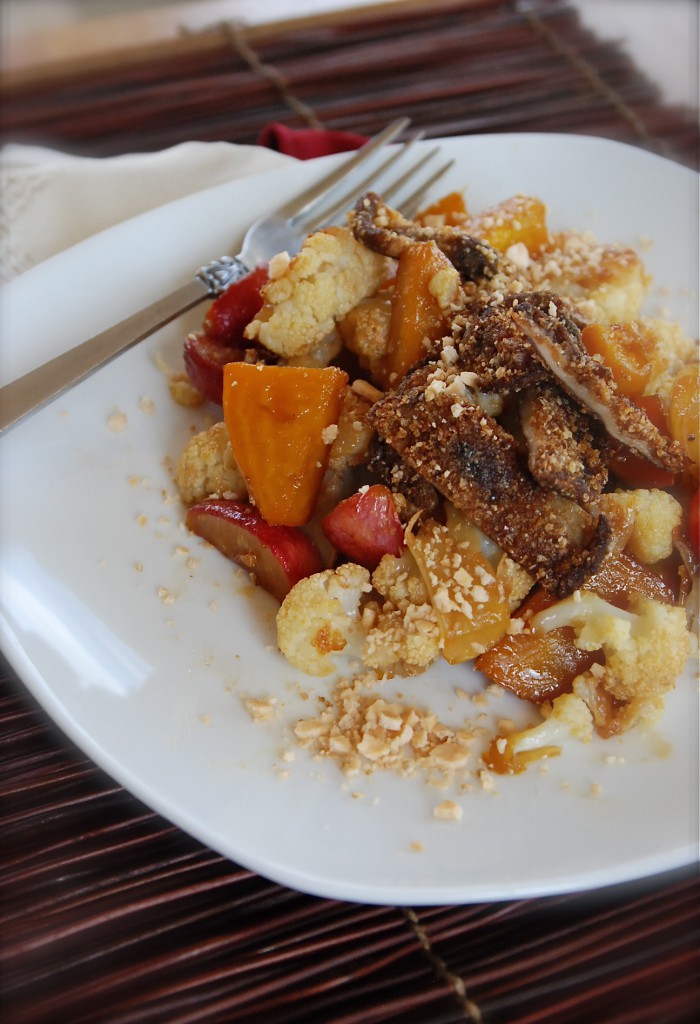
Saturday mornings are my sacred time. I rise early, with eager cats who think that the moment the birds start singing is ripe for raising their own voices, stirring the humans awake. I try to ignore Eli’s little ‘meeps’ while he negotiates the bed as light barely filters through the blind, but I can’t ignore his 16-lb frame when he steps on my head. It’s fine when all this happens around 7am in January. In May, at the prime hour of 5am, it’s a different story. But it’s his job and we respect that. Thank goodness for coffee.
And Saturday is my time. Mike rises six days a week with those critters (God bless that man) but on Saturday, he sleeps like a teenager, often until the unlikely hour of 9 or 10. It’s good for him, and those quiet moments of early sunrise, with coffee and a purring cat, are moments that are good for me. The patio door is open (though not in January) the birds sing-song chorus is cheerful, the coffee is super strong just as I like it and I have oceans of time to scan my blog reader, catch up on email or even a show on Hulu if I want. I’m often selfish with time; I like some that’s all mine, that I don’t need to share with anyone. I like being introspective, quiet and alone sometimes and these Saturday mornings are perfect for that.
I almost didn’t want to post this recipe. It was an utter ‘Hail Mary’ moment, a substitution of this for that, swapping one method for another and done in a haste that I’m almost embarrassed about. I had a small bag of fresh shiitake mushrooms, a plan and a time frame and every bit of it slipped away in the chaotic way that life takes charge and suddenly I was faced with a ‘Now or never’ option before the mushrooms became a slippery mass in their bag, and I punted blind.
The first bite to my mouth was almost interrupted by my heart pounding so badly that it nearly cut off my ability to swallow. I set some pretty high standards for myself, and no one is really holding that yardstick up to me, but me. I think I know what I’m doing; I think I can look at a recipe and recreate it in my head to be more about what I like to eat. And almost all of the time, when I head blind in to a dish, swapped out of someone else’s work, I do really well with it. It’s when I don’t trust my gut instincts and follow a recipe step by step, with all the ingredients in line like regimented soldiers that I trip up over my own indecision and end up tossing the whole thing on the compost heap.
Why do we sell ourselves short? We all do it, for one area of our lives or another. We can talk ourselves out of anything, refute the praise sent our way, shake our heads and frown at a compliment, and in our heads we make it seem so completely right, as in ‘Everyone does it and I’m not that great’. But here’s the thing: we ARE that great. We deserve those compliments and when they come, when praise rains down we shouldn’t turn from it, we should bask in it. It doesn’t mean we’re egotistical. It means something much more than that.
At my age I should think I know who I am, what I am capable of, what I enjoy eating and what I really don’t like any longer, and I SHOULD be able to rearrange a recipe without hand-wringing and self-doubt. I’m good at my craft; God gave me a gift and a skill set, and every time I stop my forward momentum and start scratching at my chin, all wrapped up in anxiety as I second guess myself, I’m portraying to Him that I don’t trust Him one bit.
Ephesians 2:10
“For we are God’s workmanship, created in Christ Jesus to do good works, which God prepared in advance for us to do”
{{I’m not here to ask, or even expect that you share my beliefs, and if you don’t,
please respect our differences as I kindly ask that you keep that to yourself}}
This very act of disavowing God’s gifts to us was discussed in a sermon in my church several months back and it sank in to my heart like a stone and settled there, and now, with conviction, every time I raise my own voice against myself, I hear His coming back to me. This is my gift, and this is HIS gift to me and I trust in Him with all my heart. It goes without saying that He is not one to retract a gift due to some misaligned belief. “Oh whoops, sorry. Those skills were meant for someone ELSE. NOT you!” He just doesn’t work in that manner. I can trust in my gifts as I trust in Him. And whether you believe or not, your specific type of faith is irrelevant. We all have amazing gifts that we can be proud of, that we can own 100% regardless of where we feel they come from. Acknowledging them is a truth that we should never deny ourselves. We don’t need belief in God for that to happen; just faith in ourselves.
And with this recipe, in my rushed state to prepare this, without a whole great plan of exactly HOW it was going to be done, like I said, I punted blind and should have just told that quickened heartbeat to ‘Shush!’ as I raised my fork. I know that I’m good enough at my craft to make this dish amazing.
Because the end result was delicious, and it was exactly like I expected it to be. And those crispy Shiitake mushrooms? What an amazing taste and crunch. I should prepare them that way just as a snack, drenched and dredged and seared to a golden crackle. I had to shoot the photos, taste the finished product and just as quickly as all that was completed, pack it away and race out the door to one of those life moments that you simply can’t miss. So I need to make this again, with time to savor and enjoy the process, the gift and the fruits of the Earth and rejoice in what I’ve been given.
Do you ever find that you second guess yourself, or you dismiss praise, or shake off a compliment??
What do you feel are your own unique gifts??
Honey-Soy Glazed Vegetables
with Crispy Mushrooms
1/2 lb Shiitake mushrooms, stems removed
1 bunch Gold Beets, with greens; trimmed, peeled and cut to bite size pieces. Greens rinsed and set aside
1 small head Cauliflower, washed and cut to bite size pieces
1 bunch Radishes, trimmed and halved
1/4 c. honey
2 T. soy sauce
1 T. fresh squeezed lemon juice
2 T. molasses
2 T. water
1 package Asian Rice Crackers, pulverized (I placed these in a large plastic bag and whacked at them with a rolling pin)
Heat your oven to 400°. Whisk the honey, soy sauce and lemon juice together and set aside. In a separate small bowl, whisk the molasses and water together and set that aside as well.
Toss beets with oil of choice, salt and pepper to taste and place on a large baking sheet. Separately, prepare cauliflower and radishes in the same manner but place on a separate sheet as they will cook at a different rate than the beets. Place both sheet pans in the oven and roast until beginning to become tender when pierced with a fork. Remove the pans from the oven and drizzle the honey-soy mixture evenly between the two pans. Stir the vegetables to coat, place back in the oven and continue to roast, stirring often, until the sauce caramelizes and the vegetables become very tender. This timing will depend on your oven and the size to which you cut the vegetables. Be sure to watch them rather carefully, as the honey in the sauce can scorch.
When veggies are done to your liking, place them in a large bowl and sprinkle about 1/4 cup of the pulverized rice crackers over them, tossing lightly to coat.
Heat a heavy skillet (cast iron if you’ve got it) with about 1/4″ of an oil that will withstand a high dose of heat, like coconut or grapeseed. Toss the shiitake mushroom caps in the molasses mixture, then coat them with the crushed rice crackers. Carefully place them, cap down in the heated oil and fry until crisp, about 5 minutes. Drain them on paper towels until cool enough to handle, then slice them in to strips.
Spoon the glazed vegetables on to plates, then top with the sliced mushrooms. Sprinkle the dish with any remaining crushed rice crackers and serve. This tasted divine served just slightly above room temperature.
KATE’S NOTES:
In my haste and scattered-ness over this recipe, I completely forgot to add the greens to the dish. They can be sauteed until tender in the skillet, just before you sear the shiitake mushrooms. I will definitely make that addition next time this dish comes through my kitchen.
November 6th, 2011
| Comments Off on farro pilaf with gold beets
There’s no other choice now. The clocks are switched, falling back; the light in the morning is better but soon the winter darkness will settle on our afternoons. Temps will drop and all sorts of things happen that we’ve been very fortunate, up until now, to have avoided.
But still, we’ve had some beautiful weather. And right now I’m sitting in the wan light of dawn watching the clouds scuttle across the sky at a fast, furious clip. The patio door is open and it’s mild for a November morning. The clouds are fascinating, wind-whipped deep blue patches racing along as if they’ve got somewhere important they need to be. I sip my coffee, watching, taking it all in.
In a few weeks we’ll have Thanksgiving, and I’m trying to take that in as well. I’m also trying to plan a menu that doesn’t focus around meat, even debating whether to just do what I want and make a completely meat-free meal, or bow to convention, and what the rest of my family expects and make a turkey. The jury is still out on that one.
I do know one of the sides I plan to make.
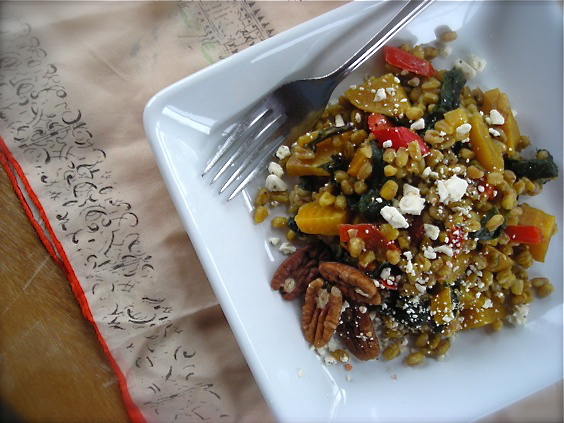 
Just about two years ago I came across this recipe, intrigued by Farro and the gold beets that I’d fallen in love with, and the first bite was a revelation. Somewhere in this dish, I began to see that a meal could be enjoyed without meat, and one that would leave me satiated without the bloat of something heavy. It was a good revelation, and something to start me on the road to better health.
Every component of this dish is not only perfect alone, but when mingled with each other makes for so much amazing texture and flavor. The Farro is chewy, with a deep nutty flavor; then you’ve got the beets and their greens to offer up a dark, earthy taste, a crisp pepper, robust cheese and a scatter of chopped pecans to add a bit more crunch. Every element of it is lovely, and on it’s own it could easily be a meal. Next to your turkey, it’s a terrific side dish.
I can’t complain about the seasonal change, the coming cold, or even the snow that’s rumored to fly soon. I’m ready, and with recipes like this, I’ll be warm from the inside too.
Got a favorite recipe or dish that keeps you warm and toasty in cold weather?
Farro Pilaf with Gold Beets
3 large gold beets, roasted and diced, with greens washed, de-ribbed and rough chopped
2-3 c. cooked farro (can sub brown rice)
1 red pepper, seeded, cored and diced
2 garlic cloves, minced
1 small shallot, diced
1/2 c. crumbled feta or goat cheese
1/3 c. pecan pieces
salt and pepper to taste
{{Farro can be cooked like any other grain, with a 2:1 ratio of water to grain; 1 cup uncooked will yield the amount needed for this recipe. It should be tender to the bite, not too firm with a texture similar to barley. Be sure to rinse it thoroughly in a wire sieve prior to cooking. It can be very dusty.}}
In a deep skillet with a tight fitting lid, heat oil of choice and add red pepper, cooking for about 5 minutes. Add shallot, cooking until soft and slightly browned, maybe 5-8 more minutes. Add garlic and cook until fragrant, 30 seconds or so. Add the chopped greens and cook, stirring continually until just barely wilted. Stir in the cooked farro and diced beets. Add about 1/3 cup of water and combine. Cover the pot, turn heat to low and cook, stirring occasionally until heated fully through. Season to taste with salt and pepper. Serve topped with cheese and nuts.
KATE’S NOTES:
The mellow flavors of the beets and farro simply beg for a good salty and robust cheese. Feta is perfect, goat cheese would be great but blue cheese and gorgonzola also would work nicely. If you can’t find Farro, use Wheat Berries, or long grain brown rice.
~~originally from The New York Times recipes for Health and Nutrition, March 27, 2009; adapted by Kate
What’s on YOUR plate this month??
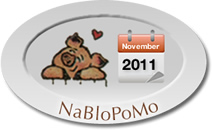
November 21st, 2009
| 3 Comments »
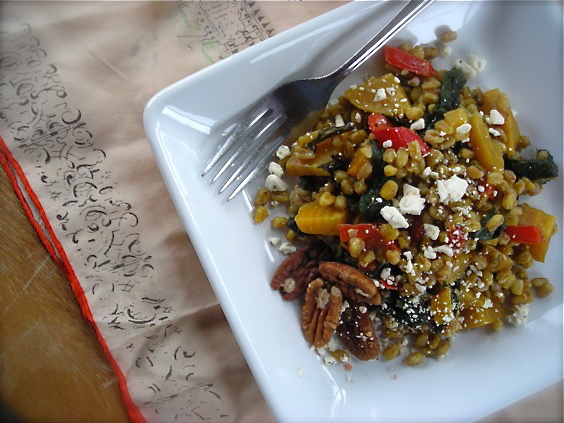 
Pictures can be amazing, can’t they?
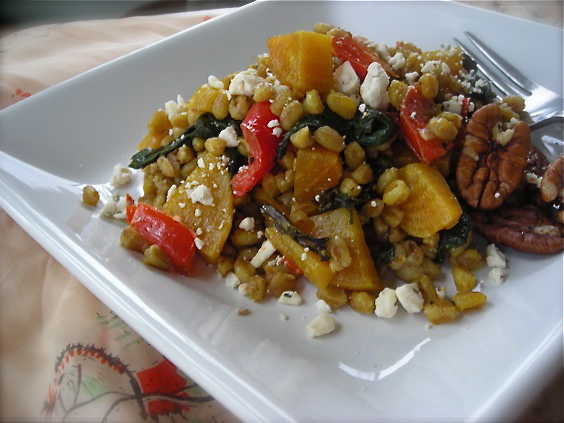
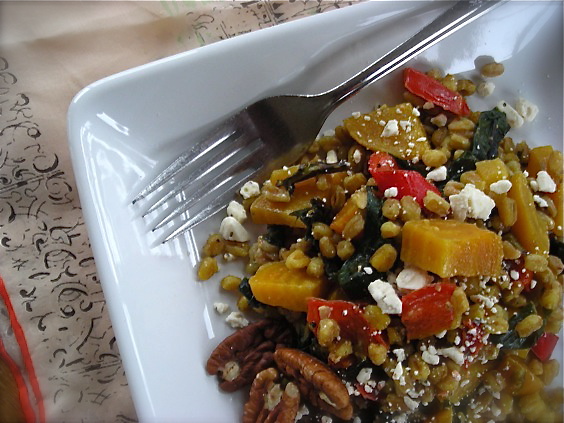
I sometimes surprise myself when I am going through the photos I’ve taken of my recipes. There are, without a doubt, the ones that hastily cause you to hit the ‘Delete’ key, shuddering in horror; they’re too close or too cloudy or they just don’t allow for one to discern what’s on the plate. They’re overexposed. Ugly. But those tiny slips caught in the wink of the shutter are evened out by beauties that can convey taste, aroma, and feel with one glance. The beauties that make you go ‘Wow’ and when you place them in your post, they literally tell the story without you needing to do much else. But every food has a story. Sometimes the tale tells of a feet-first plunge headlong into love with a certain food, a single bite causing your taste-buds to explode while the endorphins engulf your brain. You’re whupped and there’s no going back. Or it may be a telling of how we find a food that quietly asserts itself into our life, a slow and deliberate culinary courtship. Maybe the first exposure isn’t mind-blowing, but it isn’t a dud either. You look forward to the next time. You know there’s more to it than this. After a few meetings, the quiver in your heart starts to build and when you spy your current food crush, it’s silly how your chest seems to collapse in relief that you’ll be together again.
This past year I crushed, big time, into total infatuation with gold beets, and their greens. It didn’t take much. By routinely visiting the organic farmer at the local markets who carried these burnished lovelies and allowing them to roast to their full potential, I became fully acquainted with their earthy solid personality. We just clicked, those beets and I. It was quality time well spent. Mike gave me an enthusiastic endorsement for sauteed beet greens and we never looked back. Beets were in the recipe box, finally. We ate them so much that it was a turgid and satiated overkill. We sighed a lot during those dinner meals. Then high summer came, the corn took hold along with eggplants so shiny and purple, followed by a parade of tomatoes and zucchini and endless grilling adventures. Beets were nearly forgotten, sad as it was. But I was sold on the roasting method, and most days couldn’t even consider turning on the oven. They simply had to wait. I realized after a while that I missed them a great deal but I knew, like any solid friendship, that we would endure through our separation.
Then I found this recipe. It was the way back to my summer love of beets and caused me to drive across town just to find a bunch, greens attached, that would do this recipe justice. The moment we connected again was like any friendship renewed after absence. No lapse of time could remove the bond and the oven, once more, shared it’s warmth with my old friends and turned them soft and supple.
I was enamored…no, scratch that… bewitched by the flavors that came from this dish. It’s simple base of whole grain farro is more than capable of standing up to the lusty flavor and texture of beets and their greens, and the beets happily share their colors with the grain to diffuse the entire dish in sunshine-y warmth. Since 2007 I’ve been experimenting with whole grains, and I found farro to be an amicable and easy friend to bring into my life, a chewy and simple grain that mimics wheatberries and a heartier barley. Never mind that it was costly. Or that only one store I knew carried an affordable brand. Of all the whole grains I’ve encountered in the past two years, this one has become a good and trusted companion, steadfast, reliable and so so good for me. We all need friends like that in our lives, in both our hearts and our pantry.
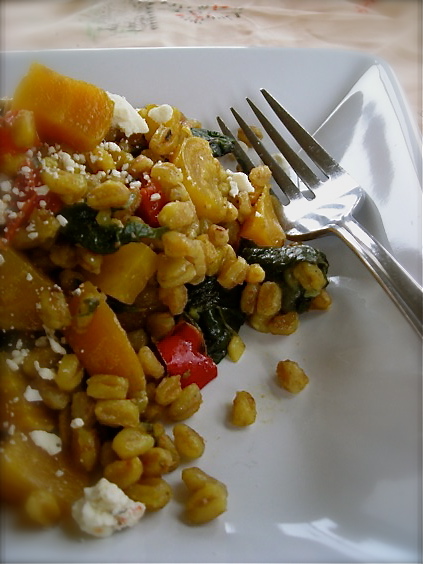
The original recipe for this dish was in salad form, but for a November meal, a cold offering wasn’t going to cut it. Even with the warm sunshine that’s been poured upon us, the chill and darkness comes quickly with the descent of the five-o’clock hour, and something steaming, whether a bowl or a plate, more appropriately fits the season. I’ll revisit the salad option next Spring when the markets open again, and I can once more hone in on that stand, with the kind bearded farmer behind the table, the dirt still stuck to his knuckles. For this time of year, and especially with the brisk wind that came up after several days of that limpid sunshine, a pilaf was exactly what we needed.
Farro is not a quick grain to cook, and you’ll find many recipes call for it to be soaked ahead of time, but I’ve discovered that to be unnecessary. Washed and placed in boiling water, the grain cooks up deliciously chewy in 35-45 minutes, and once cooked to that al denté stage, it freezes really well with little loss of texture. And maybe it’s the way it is with you too, but I roast my beets or I simply don’t eat them. Call me picky, but I never met a beet I wanted to devour before being introduced to those that mellowed in the oven, swaddled in foil, and so perfectly tender that the skins slipped off with hardly any effort. Again, this isn’t quick. I made both the farro and the beets the day prior to creating this pilaf. It worked for all of us.
Farro Pilaf with Gold Beets
originally from The New York Times recipes for Health and Nutrition, March 27, 2009; adapted by Kate
3 large gold beets, roasted and diced, with greens washed, de-ribbed and rough chopped
2-3 c. cooked farro (can sub brown rice)
1 red pepper, seeded, cored and diced
2 garlic cloves, minced
1 small shallot, diced
1/2 c. crumbled feta or goat cheese
1/3 c. pecan pieces
salt and pepper to taste
{{Farro can be cooked like any other grain, with a 2:1 ratio of water to grain; 1 cup uncooked will yield the amount needed for this recipe. It should be tender to the bite, not too firm with a texture similar to barley. Be sure to rinse it thoroughly in a wire sieve prior to cooking. It can be very dusty.}}
In a deep skillet with a tight fitting lid, heat oil of choice and add red pepper, cooking for about 5 minutes. Add shallot, cooking until soft and slightly browned, maybe 5-8 more minutes. Add garlic and cook until fragrant, 30 seconds or so. Add the chopped greens and cook, stirring continually until just barely wilted. Stir in the cooked farro and diced beets. Add about 1/3 cup of water and combine. Cover the pot, turn heat to low and cook, stirring occasionally until heated fully through. Season to taste with salt and pepper. Serve topped with cheese and nuts.
KATE’S NOTES:
The mellow flavors of the beets and farro simply beg for a good salty and robust cheese. Feta is perfect, goat cheese would be great but blue cheese and gorgonzola also would work nicely.
|











